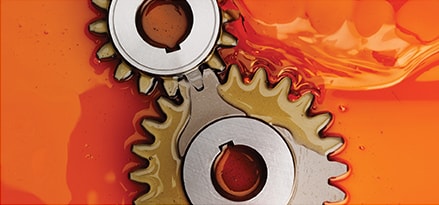
Industrial lubricants FAQ
Synthetic products are produced by chemical reactions in which pressure, temperature and the ratio of component elements are carefully controlled. This results in a pure compound with maximized lubricating properties, which can lead to enhanced energy efficiency, improved equipment protection, more reliable equipment performance and extended oil service life.
There are several Mobil industrial lubricants that are safe for the food service industry. These include the Mobil SHC Cibus™ Series, Mobil SHC Polyrex™ Series, Mobil Synturion™ 6 , Mobil Rarus™ PE, Mobil Gargolye™ and Mobilgrease™ FM Series lubricants.
You can search the globe for our distributors here.
Your best source for all passenger vehicle questions is http://www.mobil.ca.
Some of our product data sheets, such as those for lubricants with higher risk of seal incompatibility (like PAG oils), identify incompatibility issues. For best results, consult the equipment supplier or seal manufacturer for specific recommendations, or consult a Technical Help Desk engineer or a Mobil Field Engineer for general compatibility guidelines.
There are many typical indicators when looking for a good electric motor grease, including viscosity, consistency, thermo-oxidative resistance, antiwear, dropping point and shear stability.
Our primary recommendations for electric motor grease are Mobil Polyrex™ EM & EM 103* greases, which are specially designed for electric motors applications, enabling high temperature operation, long life and low noise applications.
Our secondary recommendation for electric motor grease is Mobilith SHC™ 100 – a high protection multipurpose grease. This is recommended particularly for electric motors exposed to harsh environments such as ambient temperatures below -20°C, or subject to a high level of vibrations or load.
Other recommendations for specific equipment builder applications include UNIREX™ N2 & N3 greases, which are recommend only when required to meet specific OEM approvals** (e.g., Siemens, ABB EU).
For more information please consult the Technical Topic titled “Guide to electric motor bearing lubrication.”
*Mobil Polyrex EM 103 grease mainly for vertical installed electric motors.
**Review EMEBS online for specific approvals.Greases are manufactured by combining three essential components: base oil, thickener and additives.
Base oils are the liquid portion of any grease and may be mineral, synthetic, or any fluid that contains lubricating properties.
Thickeners may be any material that, in combination with the base oil, produces the solid to semi-fluid structure.
As in lubricating oil additives, grease additives and modifiers impart special properties or modify existing ones.
For more detailed information please consult the Technical Topic titled “Grease: components, consistency and compatibility.”Mixing different types of greases can sometimes lead to incompatibility problems. Grease incompatibility results from chemical interactions between the thickener or additive systems of the dissimilar greases. In some cases, grease incompatibility can lead to equipment failure or damage of the lubricated components.
Mixtures of incompatible greases will exhibit either excessive hardening or softening relative to the consistency of the individual pure greases. The hardening or softening tendencies of the mixture will generally become more pronounced as the operating temperature increases or as the rate of shearing on the grease mixture increases.
Incompatible greases may also exhibit excessive oil separation or “bleeding” tendencies at higher temperatures.
For more information please consult the Technical Topic titled “Grease compatibility.”There are several reasons to lubricate plain bearings with grease:
- As a result of the lower end leakage, the amount of lubricant required for the bearing is lower.
- When a grease-lubricated bearing is stopped for any period of time – with the flow of lubricant shut off – the high apparent viscosity of the static grease reduces end leakage sufficiently so the grease usually does not completely drain or squeeze out.
- Some grease remains on the bearing surfaces so that a fluid film can be established almost immediately upon startup. As a result, torque and wear during the starting phase may be greatly reduced.
- During shutdown periods, retained grease also acts as a seal to prevent the entry of dirt, dust, water, water vapour and other environmental contaminants and, thus, protects the bearing surfaces against rust and corrosion.
For more information please consult the Technical Topic titled “Grease-lubricated plain bearings and grease application system.”
Mixing different greases, even those with similar thickener types, can sometimes lead to ineffective lubrication resulting in damage of the lubricated components. If not spotted soon enough this may lead to equipment failure. These situations occur due to chemical or structural interaction between the thickener or additive systems of the different greases which would be classified as “incompatible.”
Symptoms of incompatibility come in various forms. Most frequently grease mixtures will exhibit a change in consistency relative to that of the individual pure greases. This tendency will be more pronounced as the operating temperature or the rate of shearing of the grease mixture increases. Incompatible greases may also exhibit abnormal oil separation or “bleeding” at higher temperatures. If greases that are incompatible are mixed in application it could lead to grease or oil leakage, premature aging or insufficient oil bleed in the contacting zones. Although less probable but not unknown, the greases’ performance additives may act antagonistically, adversely affecting the lubrication performance such as protection against friction, wear, rust or corrosion.
For more information please consult the Technical Topic titled “Grease compatibility.”